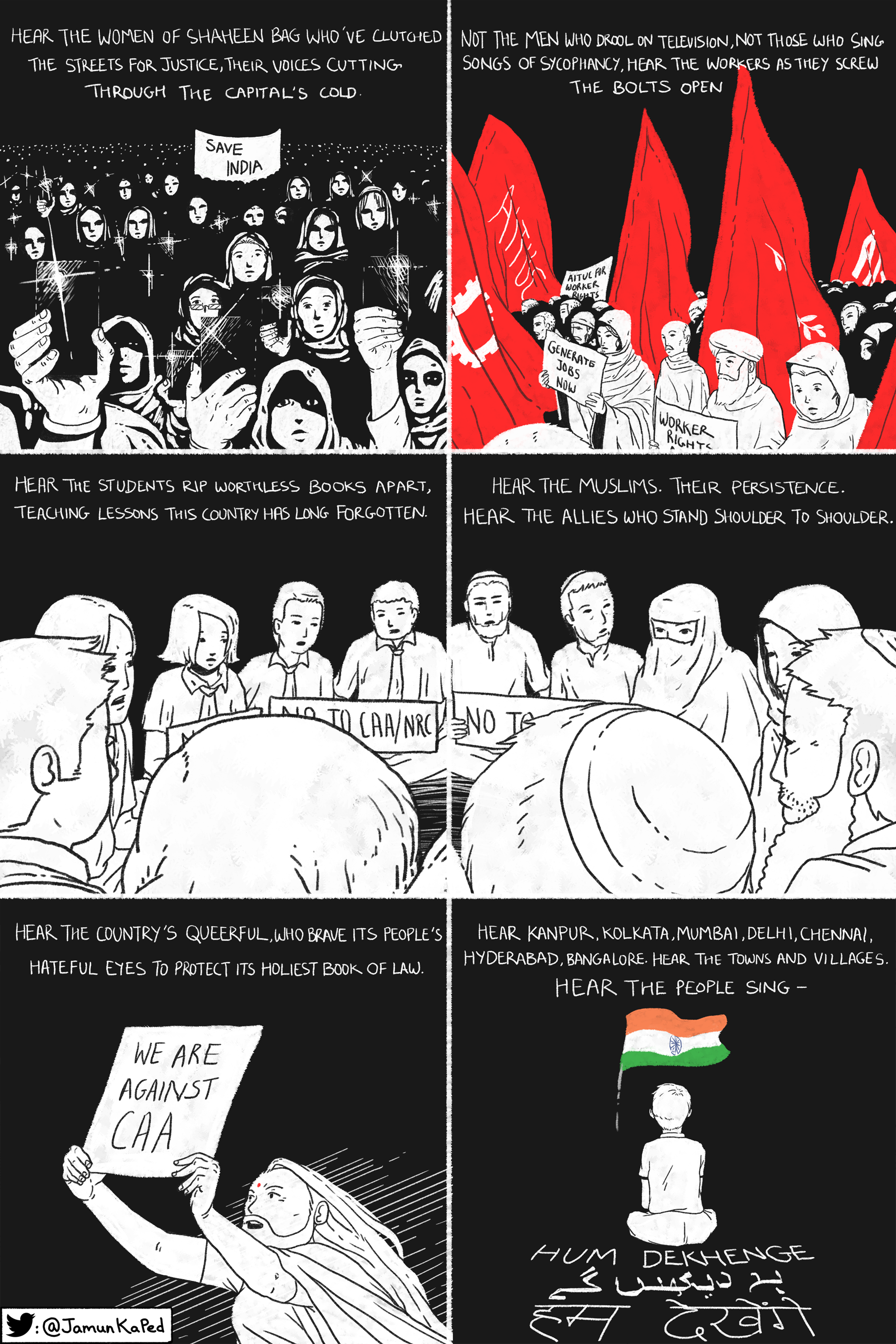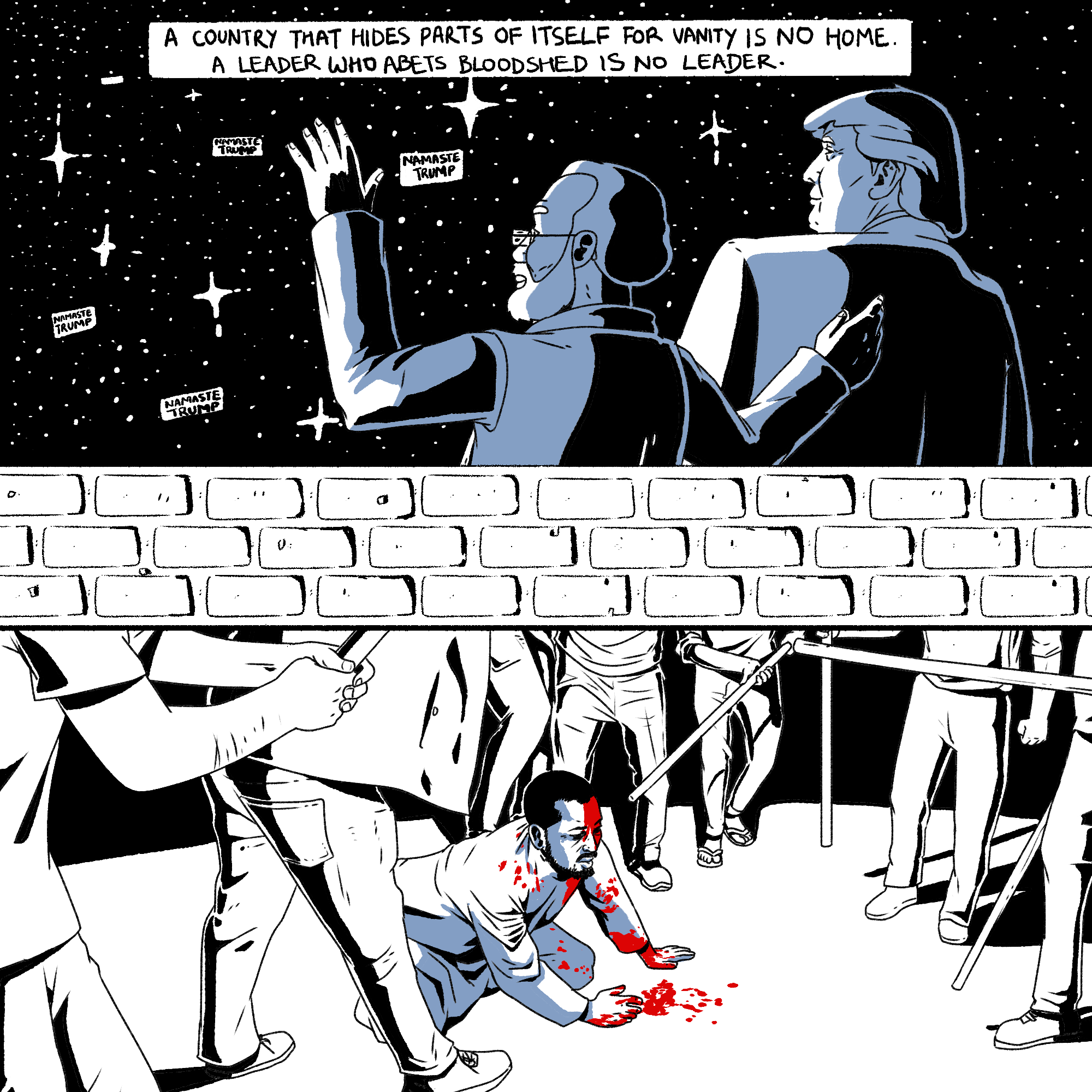With a United States rocked by protests against Police Violence, Economic Violence and the monstrous forces of White Supremacy, it may be useful to look to other global struggles against supremacy. It’s our hope to live in a world of global solidarity against violence and exploitation wherever it occurs
Here we interview Jamun Ka Ped: made up of Meher Manda and Mayukh these brave artists create images to explain India’s protests, and to defy the Hindu Supremacy of Narendra Modi.
Part 1 of our conversation can be found here
 Asia Art Tours. A major protest site that inspires me, are the women led protests of Shaheen Bagh. Could you discuss if you’ve been inspired by or documented these protests? What has been your thoughts on this Protest site? Do you see a Feminist message in their actions?
Asia Art Tours. A major protest site that inspires me, are the women led protests of Shaheen Bagh. Could you discuss if you’ve been inspired by or documented these protests? What has been your thoughts on this Protest site? Do you see a Feminist message in their actions?
Meher: We’ve not only documented the Shaheen Bagh protests, but also how the women at Jamia Milia and JNU have been at the forefront of their movements. Let’s also acknowledge that Shaheen Bagh inspired several Baghs of the kind to rise up in different parts of India, so women all over the country have been integral to the anti-CAA and NRC movement. And this isn’t a novice idea. Whether it’s the Manipuri women who protested the Army’s actions under AFSPA, or the Kashmiri women who have been instrumental in documenting the actions in their regions, women have been essential to every political movement in the country. Any movement can only succeed by claiming denied space, and women taking over public spaces is a part of that reimagination of our societies. It is definitely feminist, and not the garden variety kind, but very political and participative.
The women of Shaheen Bagh with their invocation of the Constitution and Babasaheb Ambedkar decidedly made the protest an intersectional movement. They’ve taken feminism from its theoretics and endless discourse, to practice it with integrity and intention. That is important for us to highlight.
AAT: Kashmir is increasingly a focal point for how India is unleashing state violence. Have you felt an obligation to explore Kashmir in your work? If so how do you see Kashmir in relation to other sites of Violence against Muslims globally (Palestine, Xinjiang, the US, etc.)?
Meher: The abrogation of article 370 in Kashmir was one of the deciding factors in us starting this webcomic. That Kashmir has faced the longest communication blockade of any region in a democratic country, that the autonomy and dignity of its people has been challenged and struck down, that even today, when the narrative of its people is being silenced, it’s integral for every political comic and piece of writing to highlight the injustice being carried out in Kashmir. Every Indian who speaks about the country and its administration whether locally or abroad bears responsibility to speak about Kashmir. There are no two ways about it.
Mayukh: A commentary on the Indian situation without mentioning Kashmir is an incomplete/disingenuous commentary. Kashmir has appeared in various forms in our webcomic, but I feel we certainly need to do more. The Kashmir situation is an abject failure of Indian democratic ideals and a disgrace.
 AAT: For India’s diaspora in the US and UK, why do these protests matter? Why should they be standing up to oppose the CAA, NRC and Hindutva?
AAT: For India’s diaspora in the US and UK, why do these protests matter? Why should they be standing up to oppose the CAA, NRC and Hindutva?
Meher: The diaspora, because of years of fending off racist and virulent attacks, have adopted a very on-the-nose nationalistic pride about India and its culture. But the attributes of the culture, like secularism, religious and cultural diversity, that are integral to their narrative of pride are under threat with the rise of Hindutva. Hindutva is not only anti-Muslim and anti-Dalit, but it also wants to establish a specific grain of Hinduism that is not universally accepted or followed. It derives its lessons from the Manusmiriti, upholds Brahmanical supremacy, and employs rigid views against gender equality. The CAA and NRC is simply the first step to establishing that Hindu Rashtra. So, the diaspora owes it to the narrative to care about the movement. They can only exalt the greatness of India’s diversity when such diversity exists in the first place.
Mayukh: One of the themes that have been consistent in the past few years is the retaliation that activists have suffered in India. Activists have been doxed, shot, beaten up and arrested through application of draconian colonial style laws. Being away from the country gives us space to feel comfortable enough to say things that we may not be comfortable enough to say were we in India. Of course, there are people in India who are speaking truth to power every day and are the real heroes in all of this.
Also, the Indian government (BJP) cares excessively about what it is perceived as by western nations. The diaspora protesting makes the Indian government look bad since it runs counter to the narrative that India has an active and enthusiastic diaspora that supports Indian government policies.

AAT: Lastly for those who are not Indian Citizens, or not from the larger India diaspora, how should relate to this amazing art? And can we create our own in solidarity with India (and against the CAA/NRC and Hindutva) in a way that’s intersectional?
Meher: Certainly, educating oneself with what’s happening from fact-checking, pragmatic sources over government amplified mainstream media, is integral. But beyond that, reading works, highlighting the work of writers, academics, and journalists who are reporting from ground.
Mayukh: Everyone needs to amplify dissent that’s coming out of India, especially in a climate where journalists and activists are being arrested and imprisoned. Minority voices are being overwhelmingly silenced in Indian mainstream media and the government has consistently upped its stigmatization of minorities, especially muslims. The present dispensation despite all of this seeks to project a friendly, progressive face in the international scene and if anyone could point out the rottenness in the domestic situation, it would help a lot.
Meher Manda: is a poet, short story writer, journalist, and educator from Mumbai, India, currently based in New York City. She earned her MFA in Fiction from the College of New Rochelle where she was the founding editor-in-chief of The Canopy Review. She is the author of Busted Models, the chapbook of poems from No, Dear Magazine in Fall 2019. Her work has appeared and is forthcoming in Catapult Magazine, Peach Magazine, Hobart Pulp, Los Angeles Review, Cosmonauts Avenue, and elsewhere.
Mayukh: is a Brooklyn-based animator-filmmaker who has worked extensively in advertisement space for clients such as IBM and Honda. He has made short films for NASA and #MeTooMVMT and his work has been displayed in film festivals across the world including in Sundance Film Festival.
For more on Jamun Ka Ped please head to their Social Media:
Twitter here – https://twitter.com/JamunKaPed
And Instagram here – https://www.instagram.com/jamun_ka_ped/
